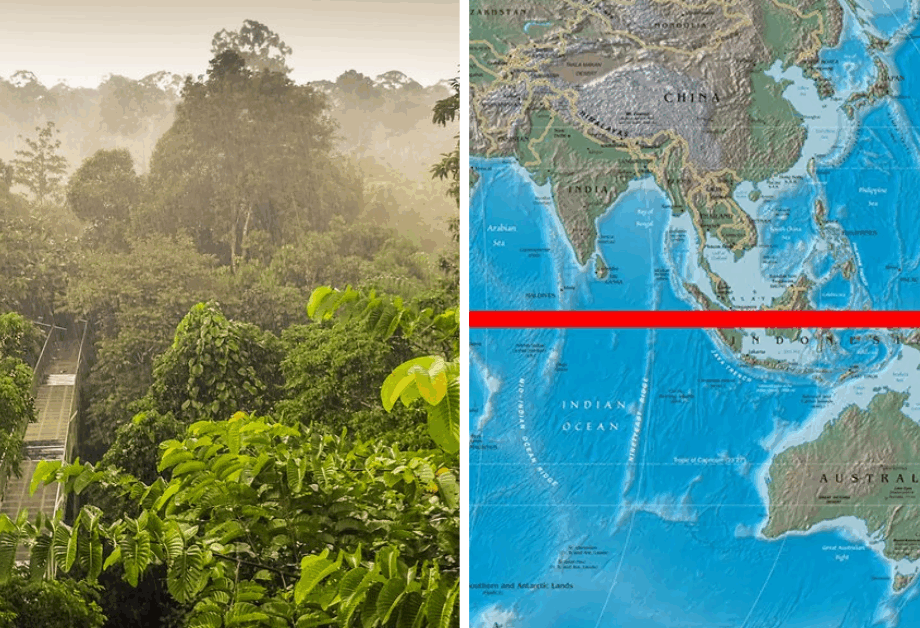Ancient forests that predate the Amazon
Malaysia’s tropical rainforests are among the oldest living ecosystems on Earth, with an age often estimated at about 130 million years. That makes them older than the Amazon, widely cited at roughly 55 million years, and older than famed natural landmarks such as Yellowstone, the Serengeti, and Banff. In places like Taman Negara and the high ridges of Gunung Tahan, the continuity of life stretches back to a time when dinosaurs still roamed the planet. This extraordinary age is not simply a romantic notion. It reflects the unusual stability of Southeast Asia’s climate and landscapes over vast stretches of time.
Unlike Europe and North America, where massive ice sheets repeatedly scraped and reset ecosystems during the Ice Age, peninsular Malaysia and Borneo sit close to the equator. The region stayed warm and wet while glaciers advanced thousands of kilometers to the north. That difference spared Malaysia’s forests from the most extreme glacial damage. Even when the climate cooled, valleys, sheltered slopes, and river corridors held pockets of warmth and moisture. These natural refuges gave plants and animals a place to survive until conditions improved, so the forests did not have to start over from scratch. Over millions of years, complexity kept building.
Geology also set the stage. Much of the region lies on the Sunda Shelf, a stable platform of continental crust with mountains, ridges, and river networks shaped during the Jurassic and Cretaceous periods. Ancient landforms created consistent habitats across elevations and soil types. The dominant tree family, the dipterocarps, rose to form towering canopies that define Southeast Asian rainforests. With time and stability, species radiated across slopes, valleys, and ridgelines, creating a living library of biodiversity that is rare on a global scale.
How did these rainforests survive the ice ages
The last glacial maximum peaked about 21,000 years ago. Ice sheets grew across high latitudes, sea levels dropped by more than 100 meters, and land bridges connected present day Malaysia, Borneo, Sumatra, and the Asian mainland. Across this expanded Sunda Shelf, the climate stayed tropical. Seasonal rains persisted and humid forests clung to hillsides and sheltered basins. Glaciers never reached this far south, so the structure of the rainforests remained intact where suitable microclimates existed.
Scientists use the term refugia for those pockets where species could ride out cooler or drier periods. In Malaysia, valleys with dependable water, mountain slopes that caught cloud moisture, and riparian forests along rivers served as natural arks. When conditions shifted back toward warmer and wetter, species spread out again. Repeated cycles of contraction and expansion produced a layered, resilient web of life.
This history explains why ancient lineages still thrive. Malaysia is home to the Malayan tapir, many hornbill species, giant flowering rafflesia, and carnivorous pitcher plants. Forest mammals, birds, amphibians, insects, and fungi occupy niches across a patchwork of lowland forests, hill forests, montane forests, peat swamps, and mangroves. Older ecosystems had time to accumulate diversity and specialized interactions that make the region one of the world’s biodiversity capitals.
What makes Malaysia’s rainforests unique today
Across peninsular Malaysia and Malaysian Borneo, biodiversity is breathtaking by any measure. Peninsular Malaysia alone hosts more than 15,000 species of flowering plants, and a single hectare of mature rainforest can contain up to 300 different tree species. Malaysian Borneo supports at least 600 bird species, including eight hornbill species. The country is recognized as one of the planet’s megadiverse nations and maintains a policy commitment to keep at least half of its land under forest. Current estimates place national forest cover at around 54.58 percent, or about 18.05 million hectares, across mangroves, peat swamps, lowland dipterocarp forests, and hill and montane forests.
Iconic wildlife includes the critically endangered Malayan tiger, Asian elephant, Bornean orangutan, proboscis monkey, pygmy elephant, sun bear, and clouded leopard. Forest giants like dipterocarps form canopies that can reach 60 meters or more, while the understory supports orchids, ferns, and numerous endemic plants. Hornbills and primates disperse seeds, predators keep herbivore populations in check, and a multitude of insects pollinate flowers and recycle nutrients. The rainforest works as a finely tuned system built through deep time.
Peninsular Malaysia landmarks
Taman Negara, spanning about 4,300 square kilometers across Pahang, Kelantan, and Terengganu, is often cited as a classic example of an ancient rainforest. Protected since 1938, it offers a canopy walkway, night safaris, river journeys, and challenging treks, including the multi day ascent of Mount Tahan. The Batek, an indigenous community with deep knowledge of the forest, maintain cultural ties to these lands. Visitors commonly plan trips between March and September when conditions are usually drier.
Other peninsular highlights include the Belum Temengor landscape in Perak, where all 10 of Malaysia’s hornbill species can be found across the broader complex, and Endau Rompin National Park on the Johor Pahang border, known for rugged trails, waterfalls, and old lowland forests. These areas offer a window into the flora and fauna that survived past climate swings and continue to adapt.
Malaysian Borneo stronghold
In Sabah and Sarawak, Malaysian Borneo holds some of the last large expanses of ancient forest. The Danum Valley Conservation Area is a reference site for lowland rainforest ecology. The Maliau Basin, often called Sabah’s Lost World, protects a remote amphitheater of forest and waterfalls. The Kinabatangan floodplain in Sabah is both an Important Bird Area and a Key Biodiversity Area, a lifeline for elephants, proboscis monkeys, and orangutans moving along river corridors. Sabah lists about 215 mammal species, and about 40 percent are of conservation concern, reflecting how fragile even rich ecosystems can be when fragmented.
Conservation initiatives in Malaysian Borneo increasingly focus on reknitting habitats. Projects such as the Keruak Species Corridor and the Keruak Virgin Jungle Reserve seek to connect forest patches, allowing wildlife to move safely between feeding and breeding areas. Restoration efforts on former plantations, including the Genting Species Corridor initiative, are turning degraded land back into forest pathways. These projects also stabilize riverbanks, reduce erosion, and support local fisheries that provide essential protein for nearby communities, including the orang sungai, or river people.
A living laboratory for science and discovery
Malaysia’s ancient forests are also prime sites for research and innovation. On Penang Hill, an international team that included scientists from the California Academy of Sciences and Universiti Sains Malaysia conducted a comprehensive biodiversity survey of forests and streams. Work there included the first concerted attempt in Malaysia to study canopy biodiversity, since much of tropical life resides high above the ground. Researchers collected samples from different levels of tree crowns, archiving leaves in herbaria to create a baseline for future study. By comparing leaf morphology, stomata, and stable carbon isotopes over time, researchers can track how trees respond as temperatures, rainfall, and carbon dioxide levels shift. Education infrastructure such as the canopy walks at The Habitat allows the public to experience forest layers that were once only accessible to scientists, while local partners work toward recognition of the broader landscape as a UNESCO Biosphere Reserve.
Listening technology is also reshaping conservation. Bioacoustics uses weatherproof recorders to capture the soundscape of the forest, from gibbon songs at dawn to the wingbeats of hornbills and the evening chorus of insects and frogs. Because many species have distinctive calls, recordings provide a noninvasive way to track wildlife. The approach scales across large areas and long periods with minimal human disturbance, especially when devices are solar powered and can transmit data remotely. In Sabah, efforts such as the SAFE Acoustics Project are building sound libraries to compare intact forests with logged areas and plantations, while similar work in Penang is documenting change through time.
Audio data is increasingly paired with artificial intelligence. Algorithms can learn to detect chainsaws or trucks, alerting rangers to suspected illegal activity. In elephant range, predictive models that draw on acoustic cues and movement patterns can warn communities when herds approach plantations, reducing conflict while keeping animals safe. The same large scale listening can flag abnormal silences that signal stress after fire or drought. Sound turns into evidence that guides on the ground decisions about protection and restoration.
Pressures on an ancient ecosystem
The age of Malaysia’s rainforests does not make them invulnerable. Across Borneo, forest loss surged in the late twentieth century and continued into the new millennium. Analyses indicate that about half of Borneo’s rainforest was lost between 1973 and 2015. In Sabah and Sarawak, the share of primary forest fell by about 17.9 percent between 2002 and 2019. The main drivers are logging, conversion to plantations, and fire. When forest is cleared, soils erode, fertility drops, and rivers carry heavy sediment loads. Fragmentation breaks large habitats into small, isolated pieces that cannot support viable populations of wide ranging mammals. Hunting pressure and wildlife trade add further stress, and climate change amplifies risk through heatwaves and drought that make peat swamps more prone to fire.
Palm oil is central to this story and to the regional economy. Malaysia and Indonesia together supply about 87 percent of the global market. Palm oil is used in food, household goods, cosmetics, and biofuel. It has raised incomes for many producers and supports significant employment. At the same time, large scale conversion has been a major cause of habitat loss and fragmentation. Research suggests that since 2000 a large share of forests cleared in Borneo have been replanted with oil palm, with one analysis indicating roughly 39 percent of cleared forests became plantations between 2000 and 2018. The challenge is to align livelihoods with land management that keeps remaining ancient forests standing.
Conservation strategies that deliver results
Protection is shifting from isolated parks to networks and corridors that keep landscapes connected. The tri national Heart of Borneo initiative, launched in 2007, seeks to secure a large block of intact forest across Malaysia, Indonesia, and Brunei through protected areas and sustainable forest management. On the ground in Sabah, projects like the Keruak Species Corridor and community led reforestation by partners such as HUTAN are linking fragments along the Kinabatangan River. Planting native trees reduces erosion, keeps river channels stable, improves water quality, and supports better catches for communities that rely on fisheries. At Genting Highlands, field programs, nature photography, and youth ranger activities are raising awareness, while recent documentation of a tiny forest plant, Thismia limkokthayi, shows how much biodiversity still remains to be discovered and protected. Tissue culture work is underway to safeguard this critically endangered species.
Research from Malaysian Borneo also shows that logged forests retain high conservation value. A study that compared mammals across virgin forest, logged forest, and oil palm found that while species richness can be lower at very small scales in logged areas, the variety across sites is often higher. Ecologists call this beta diversity, the difference in species composition between locations. When viewed at a landscape scale, large logged forests can support mammal communities comparable to old growth, provided hunting is controlled and further conversion is halted. That result is important for policy. It signals that keeping large tracts of altered forest intact is far better for biodiversity than replacing them with plantations.
People, livelihoods, and eco tourism
Indigenous communities have lived with these forests for generations. The Orang Asli of peninsular Malaysia, including the Batek who maintain ties to Taman Negara, hold knowledge about edible plants, medicinal herbs, wildlife behavior, and seasonal patterns that cannot be found in textbooks. Their participation in decision making and respect for customary rights are essential to lasting conservation. Industrial logging and oil extraction have displaced some communities and introduced illnesses, threatening both health and culture. Stronger safeguards, co management, and fair benefits can align conservation with community wellbeing.
Eco tourism offers a practical bridge between protection and livelihoods. In peninsular Malaysia, visitors walk the canopy walkway at Taman Negara, explore caves, take river trips to the Kelah Sanctuary, and learn from guides who interpret tracks and bird calls. In Borneo, Sepilok provides a window into orangutan rehabilitation, while the Danum Valley Conservation Area and the Maliau Basin offer world class rainforest experiences. Gunung Mulu National Park in Sarawak is renowned for its karst towers and the evening bat exodus. In Perak, the Belum Temengor area supports wildlife watching from houseboats and forest trails. Genting Highlands has repositioned nature trails as a draw of their own, and the discovery of Thismia limkokthayi underscores the scientific value of careful exploration. Collaborations involving researchers, local groups, and private partners can turn nature documentation into better protection on the ground.
Responsible travel can strengthen conservation. Choosing local guides, avoiding litter, staying on marked paths, and respecting wildlife help keep impacts low. Visitor spending supports jobs in guiding, research, and park management, making standing forests more valuable than cleared land.
Why this matters far beyond Malaysia
Ancient rainforests are planetary infrastructure. Tropical forests cover only about 6 percent of Earth’s surface yet hold more than half of known species. Their trees store vast amounts of carbon, cool the air through transpiration, and help generate rain across regions. In Malaysia, forested watersheds regulate flows that reduce flood risk downstream. Tree roots stabilize slopes and soils, lowering the chance of landslides during intense storms. Mangroves shield coastal communities from storm surge by breaking waves and trapping sediment.
Rainforests also carry enormous scientific and medical potential. More than a quarter of modern medicines trace back to compounds first found in plants, yet only about one percent of tropical plant species has been screened for pharmacological use. Losing a forest is losing options, whether for science, for food security, or for climate resilience. Keeping Malaysia’s ancient rainforests intact protects a living system that benefits local communities and contributes to global stability.
Key Points
- Malaysia’s rainforests are about 130 million years old, older than the Amazon.
- Equatorial climate and refugia spared the region from glacial resets that erased many northern forests.
- Ancient geology on the Sunda Shelf provided stable habitats for species to evolve over long spans of time.
- Peninsular Malaysia hosts over 15,000 flowering plant species and up to 300 tree species per hectare.
- Malaysian Borneo is home to orangutans, pygmy elephants, proboscis monkeys, sun bears, and eight hornbill species.
- Malaysia maintains more than 50 percent national forest cover across mangroves, peat swamps, lowland dipterocarp, and hill and montane forests.
- Borneo has lost large areas of forest since the 1970s, driven by logging, plantation expansion, and fire.
- Connectivity projects and restoration in Sabah are rebuilding corridors that support wildlife and local fisheries.
- Bioacoustics and other technologies provide large scale, low impact tools to monitor biodiversity and detect threats.
- Logged forests still hold high conservation value when protected from hunting and conversion to plantations.




